第六章、辉光放电(glowdischarge)
- 格式:doc
- 大小:653.00 KB
- 文档页数:22
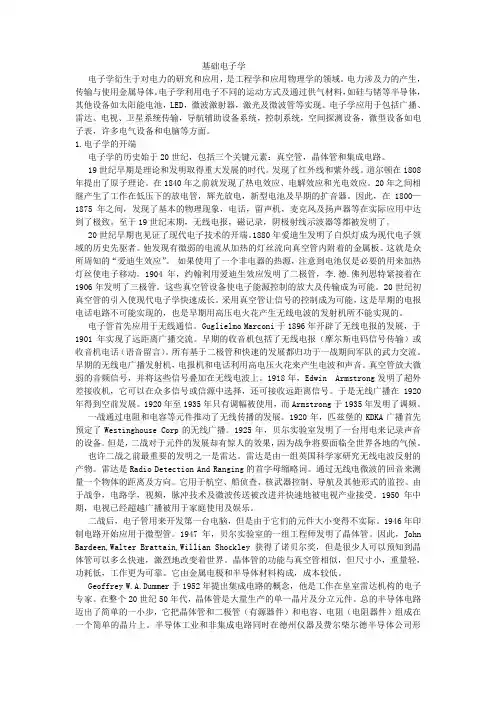
基础电子学电子学衍生于对电力的研究和应用,是工程学和应用物理学的领域。
电力涉及力的产生,传输与使用金属导体。
电子学利用电子不同的运动方式及通过供气材料,如硅与锗等半导体,其他设备如太阳能电池,LED,微波激射器,激光及微波管等实现。
电子学应用于包括广播、雷达、电视、卫星系统传输,导航辅助设备系统,控制系统,空间探测设备,微型设备如电子表,许多电气设备和电脑等方面。
1.电子学的开端电子学的历史始于20世纪,包括三个关键元素:真空管,晶体管和集成电路。
19世纪早期是理论和发明取得重大发展的时代。
发现了红外线和紫外线。
道尔顿在1808年提出了原子理论。
在1840年之前就发现了热电效应、电解效应和光电效应。
20年之间相继产生了工作在低压下的放电管,辉光放电,新型电池及早期的扩音器。
因此,在1800—1875年之间,发现了基本的物理现象,电话,留声机,麦克风及扬声器等在实际应用中达到了极致。
至于19世纪末期,无线电报,磁记录,阴极射线示波器等都被发明了。
20世纪早期也见证了现代电子技术的开端。
1880年爱迪生发明了白炽灯成为现代电子领域的历史先驱者。
他发现有微弱的电流从加热的灯丝流向真空管内附着的金属板。
这就是众所周知的“爱迪生效应”。
如果使用了一个非电器的热源,注意到电池仅是必要的用来加热灯丝使电子移动。
1904年,约翰利用爱迪生效应发明了二极管,李.德.佛列思特紧接着在1906年发明了三极管。
这些真空管设备使电子能源控制的放大及传输成为可能。
20世纪初真空管的引入使现代电子学快速成长。
采用真空管让信号的控制成为可能,这是早期的电报电话电路不可能实现的,也是早期用高压电火花产生无线电波的发射机所不能实现的。
电子管首先应用于无线通信。
Guglielmo Marconi于1896年开辟了无线电报的发展,于1901年实现了远距离广播交流。
早期的收音机包括了无线电报(摩尔斯电码信号传输)或收音机电话(语音留言)。
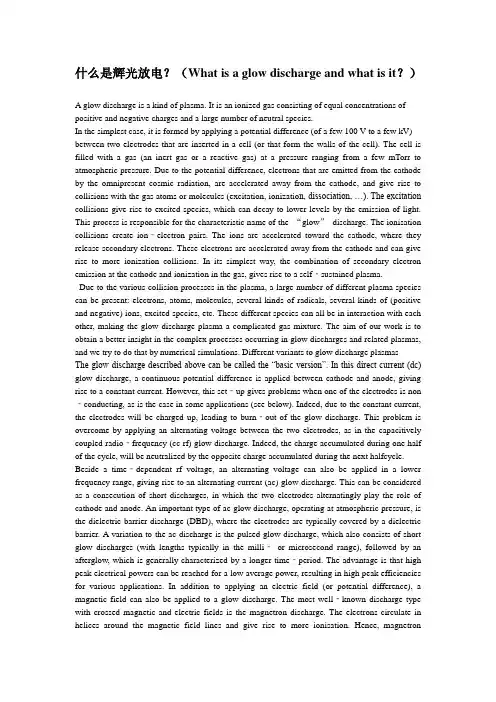
什么是辉光放电?(What is a glow discharge and what is it?)A glow discharge is a kind of plasma. It is an ionized gas consisting of equal concentrations of positive and negative charges and a large number of neutral species.In the simplest case, it is formed by applying a potential difference (of a few 100 V to a few kV) between two electrodes that are inserted in a cell (or that form the walls of the cell). The cell is filled with a gas (an inert gas or a reactive gas) at a pressure ranging from a few mTorr to atmospheric pressure. Due to the potential difference, electrons that are emitted from the cathode by the omnipresent cosmic radiation, are accelerated away from the cathode, and give rise to collisions with the gas atoms or molecules (excitation, ionizatio n, dissociation, …). The excitation collisions give rise to excited species, which can decay to lower levels by the emission of light. This process is responsible for the characteristic name of the “glow”discharge. The ionisation collisions create ion‐electron pairs. The ions are accelerated toward the cathode, where they release secondary electrons. These electrons are accelerated away from the cathode and can give rise to more ionization collisions. In its simplest way, the combination of secondary electron emission at the cathode and ionization in the gas, gives rise to a self‐sustained plasma.Due to the various collision processes in the plasma, a large number of different plasma species can be present: electrons, atoms, molecules, several kinds of radicals, several kinds of (positive and negative) ions, excited species, etc. These different species can all be in interaction with each other, making the glow discharge plasma a complicated gas mixture. The aim of our work is to obtain a better insight in the complex processes occurring in glow discharges and related plasmas, and we try to do that by numerical simulations. Different variants to glow discharge plasmasThe glow discharge described above can be called the “basic version”. In this direct current (dc) glow discharge, a continuous potential difference is applied between cathode and anode, giving rise to a constant current. However, this set‐up gives problems when one of the electrodes is non ‐conducting, as is the case in some applications (see below). Indeed, due to the constant current, the electrodes will be charged up, leading to burn‐out of the glow discharge. This problem is overcome by applying an alternating voltage between the two electrodes, as in the capacitively coupled radio‐frequency (cc rf) glow discharge. Indeed, the charge accumulated during one half of the cycle, will be neutralized by the opposite charge accumulated during the next halfcycle. Beside a time‐dependent rf voltage, an alternating voltage can also be applied in a lower frequency range, giving rise to an alternating current (ac) glow discharge. This can be considered as a consecution of short discharges, in which the two electrodes alternatingly play the role of cathode and anode. An important type of ac glow discharge, operating at atmospheric pressure, is the dielectric barrier discharge (DBD), where the electrodes are typically covered by a dielectric barrier. A variation to the ac discharge is the pulsed glow discharge, which also consists of short glow discharges (with lengths typically in the milli‐or microsecond range), followed by an afterglow, which is generally characterized by a longer time‐period. The advantage is that high peak electrical powers can be reached for a low average power, resulting in high peak efficiencies for various applications. In addition to applying an electric field (or potential difference), a magnetic field can also be applied to a glow discharge. The most well‐known discharge type with crossed magnetic and electric fields is the magnetron discharge. The electrons circulate in helices around the magnetic field lines and give rise to more ionisation. Hence, magnetrondischarges are typically operated at lower pressures and higher currents than conventional glow discharges. Recently, some new discharge types have been developed, which are also characterized by low pressure and high plasma densities, and which have their main application in the semiconductor industry and for materials technology. The major difference with the conventional glow discharge is that the electrical power is not applied through a potential difference between two electrodes, but through a dielectric window. The two most important “high‐density sources”, are the inductively coupled discharge, where the rf power is inductively coupled to the plasma, and the electron cyclotron resonance reactor, where microwave power and a magnetic field are applied. Microwave power can also be applied in so‐called microwave induced plasmas. V arious discharge types can be classified under this name, among others the resonance cavity plasmas, free expanding plasma torches and surface wave discharges. In fact, the list of discharge plasmas related to glow discharges is longer than this. But because they are at this moment beyond the research interest of our group, we will not go into detail here. More information can be found in: A. Bogaerts, E. Neyts, R. Gijbels and J.J.A.M. van der Mullen, Gas discharge plasmas and their applications, Spectrochimica Acta B, 57, 609‐658 (2002). Applications of glow discharges and related plasmas Glow discharges and related plasmas are used in a large number of application fields. The most important application is probably in the microelectronics industry and in materials technology, for surface treatment, etching of surfaces (e.g., for the fabrication of integrated circuits), deposition of thin protective coatings, plasma polymerisation, plasma modification of polymers and other surfaces. The exciting and light emitting character of discharge plasmas is also used for several interesting applications, such as in the light industry (e.g., fluorescence lamps, neon advertisements), as gas lasers, and as flat plasma display panels for the new generation of flat, large area television screens. Because a lot of chemical reactions take place in the plasma, several types of discharges (mainly atmospheric pressure glow discharges and dielectric barrier discharges) find also increasing interest for environmental applications (e.g., the destruction of volatile organic compounds) and biomedical applications (e.g., the sterilisation of materials).Finally, an application of glow discharges that is of special interest to our group is its use in analytical chemistry, for the spectrochemical trace analysis of (mainly solid) materials.。
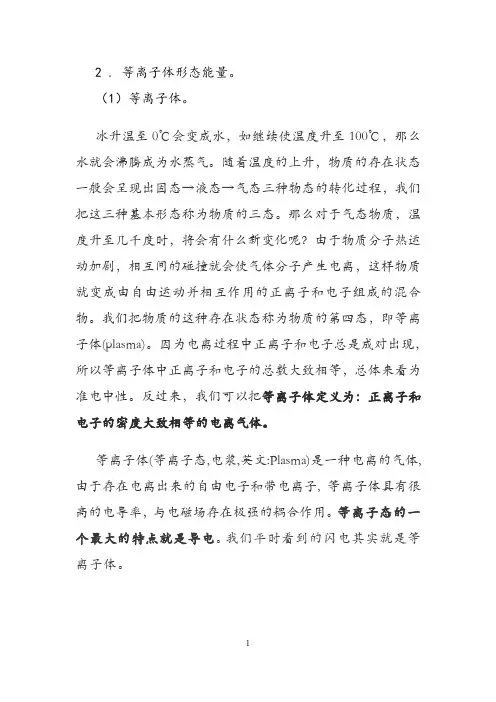
2 . 等离子体形态能量。
(1)等离子体。
冰升温至0℃会变成水,如继续使温度升至100℃,那么水就会沸腾成为水蒸气。
随着温度的上升,物质的存在状态一般会呈现出固态→液态→气态三种物态的转化过程,我们把这三种基本形态称为物质的三态。
那么对于气态物质,温度升至几千度时,将会有什么新变化呢?由于物质分子热运动加剧,相互间的碰撞就会使气体分子产生电离,这样物质就变成由自由运动并相互作用的正离子和电子组成的混合物。
我们把物质的这种存在状态称为物质的第四态,即等离子体(plasma)。
因为电离过程中正离子和电子总是成对出现,所以等离子体中正离子和电子的总数大致相等,总体来看为准电中性。
反过来,我们可以把等离子体定义为:正离子和电子的密度大致相等的电离气体。
等离子体(等离子态,电浆,英文:Plasma)是一种电离的气体, 由于存在电离出来的自由电子和带电离子, 等离子体具有很高的电导率,与电磁场存在极强的耦合作用。
等离子态的一个最大的特点就是导电。
我们平时看到的闪电其实就是等离子体。
等离子体由克鲁克斯在1879年发现,“Plasma”这个词,由朗廖尔在1928 年最早采用。
等离子体是存在最广泛的一种物态,目前观测到的宇宙能量物质中,99%都是等离子体。
等离子体是继固态、液态、气态之后的能量第四态,当外加电压达到击穿电压时,气体分子被电离,产生包括电子、离子、原子和原子团在内的混合体。
(见《低温等离子体》《什么是等离子体》《电离辐射》词条)由于热运动和电磁力的作用,从某个分子逸出的电子可能与另一失去电子的阳离子碰撞而复合,也可与中性分子暂时结合而成阴离子。
电离辐射是指能量足够高而能使原子或分子中的电子解离、也就是使他们电离的辐射。
电离辐射通常包括高能亚原子粒子和离子、高速运动的原子(通常大于光速的1%),以及高能电磁波。
γ射线、x射线,以及紫外线中的高能部分属于电离辐射,紫外线中低能部分以及所有紫外线以下的所有频谱,包括可见光(包括几乎所有类型的激光)、红外线、微波、无线电波则属于非电离辐射。
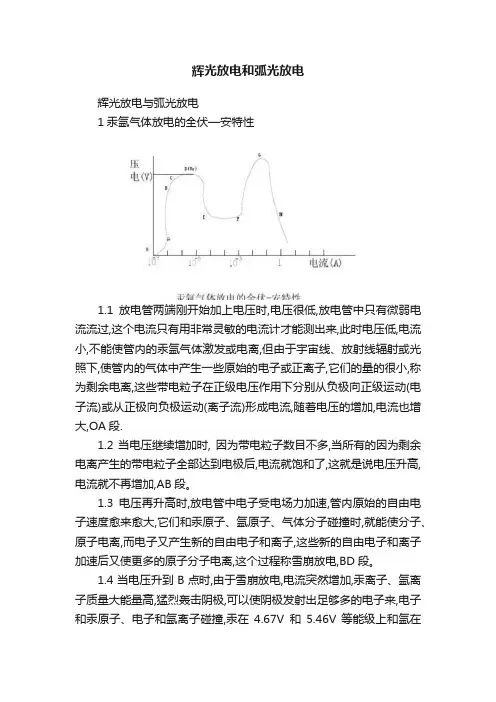
辉光放电和弧光放电辉光放电与弧光放电1汞氩气体放电的全伏—安特性1.1放电管两端刚开始加上电压时,电压很低,放电管中只有微弱电流流过,这个电流只有用非常灵敏的电流计才能测出来,此时电压低,电流小,不能使管内的汞氩气体激发或电离,但由于宇宙线、放射线辐射或光照下,使管内的气体中产生一些原始的电子或正离子,它们的量的很小,称为剩余电离,这些带电粒子在正级电压作用下分别从负极向正级运动(电子流)或从正极向负极运动(离子流)形成电流,随着电压的增加,电流也增大,OA段.1.2当电压继续增加时, 因为带电粒子数目不多,当所有的因为剩余电离产生的带电粒子全部达到电极后,电流就饱和了,这就是说电压升高,电流就不再增加,AB段。
1.3电压再升高时,放电管中电子受电场力加速,管内原始的自由电子速度愈来愈大,它们和汞原子、氩原子、气体分子碰撞时,就能使分子、原子电离,而电子又产生新的自由电子和离子,这些新的自由电子和离子加速后又使更多的原子分子电离,这个过程称雪崩放电,BD段。
1.4当电压升到B点时,由于雪崩放电,电流突然增加,汞离子、氩离子质量大能量高,猛烈轰击阴极,可以使阴极发射出足够多的电子来,电子和汞原子、电子和氩离子碰撞,汞在4.67V和5.46V 等能级上和氩在11.53和11.72能级上并不辐射,这些状态称亚稳态,亚稳态在气体放电灯中的启动时可作出重要贡献。
亚稳态原子与电子或其它粒子碰撞时,除了可能产生逐级激发或逐级电离外,也能把激发能交给电子或其它粒子,发生第二类非弹性碰撞.其中,潘宁效应是气体放电中最有用的第二类非弹性碰撞.在适当的两种气体组成的的混合气体中.它的着火电位要低于单种气体的着火电位.这个效应称为潘宁效应,它可用下式来表达.A* B→A B* e ΔE(ΔE是粒子碰撞后多余的一部分动能)此过程说明,激发态A*原子与B原子相碰, A*原子把自己的激发能转移给B 原子,使B原子电离.这里A*的激发能应大于或至少等于B原子的电离能. A*的激发能越接近于B原子的电离能,这种激发转移的几率就越大.一般来说, A*是亚稳态,因为它能在该能级上停留足够时间长,A*与B原子有足够长的相互作用时间,因此,发生潘宁效应的几率就大了.所以在低压汞荧光灯中,除了Hg以外,还充以适量的氩气,以形成潘宁效应,从而降低灯的启动电压.图D,称为放电着火,相应于D点的电压称为着火电压。
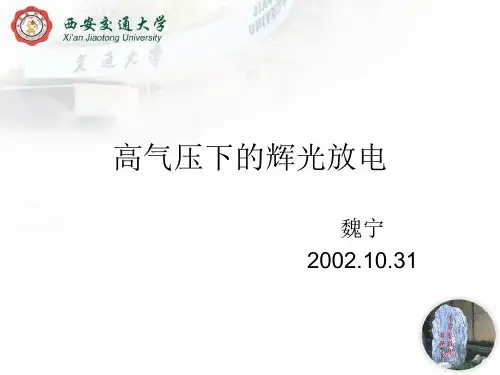
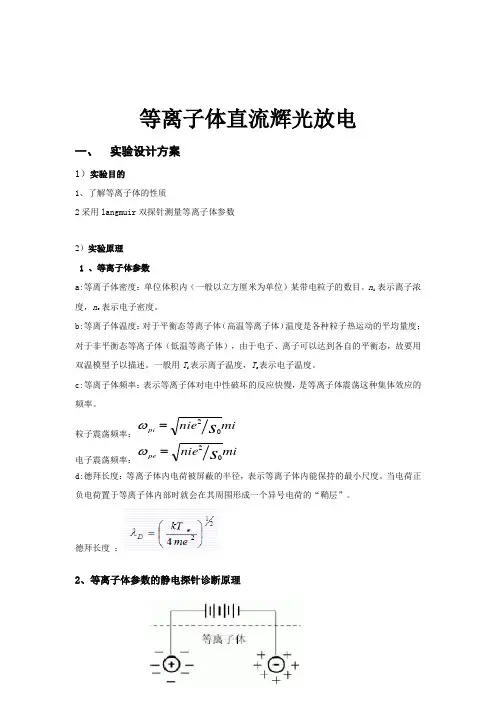
等离子体直流辉光放电一、实验设计方案1)实验目的1、了解等离子体的性质2采用langmuir双探针测量等离子体参数2)实验原理1 、等离子体参数a:等离子体密度:单位体积内(一般以立方厘米为单位)某带电粒子的数目。
n i 表示离子浓度,n e 表示电子密度。
b:等离子体温度:对于平衡态等离子体(高温等离子体)温度是各种粒子热运动的平均量度;对于非平衡态等离子体(低温等离子体),由于电子、离子可以达到各自的平衡态,故要用双温模型予以描述。
一般用T i表示离子温度,T e表示电子温度。
c:等离子体频率:表示等离子体对电中性破坏的反应快慢,是等离子体震荡这种集体效应的频率。
粒子震荡频率:m inie spi02=ω电子震荡频率:m inie spe02=ωd:德拜长度:等离子体内电荷被屏蔽的半径,表示等离子体内能保持的最小尺度。
当电荷正负电荷置于等离子体内部时就会在其周围形成一个异号电荷的“鞘层”。
德拜长度:2、等离子体参数的静电探针诊断原理图8、等离子体探针原理图9、单探针法图10、双探针法假设:(1)、被测空间是电中性的等离子体空间,电子密度n e和离子浓度n i 相等,电子与离子的速度满足麦克斯韦速度分布;(2)、探针周围形成的空间电荷鞘层厚度比探针面积的线度小,这样可忽略边缘效应,近似认为鞘层和探针的面积相等;(3)、电子和正离子的平均自由程比鞘层厚度大,这样可忽略鞘层中粒子碰撞引起的弹性散射、粒子激发和电离;(4)、探针材料与气体不发生化学反应;(5)、探针表面没有热电子和次级电子的发射。
则:对于插入等离子体的单探针有:随机电流:S r A eJ I -=,218441⎪⎭⎫ ⎝⎛==m T n U n J e r根据玻耳兹曼定理:电子密度)exp(0esP kT V V en n -=式中:V p 为探针电位,V s 为等离子体电位所以:探针电流S e e S P A m T kT V V e en I 2108exp 4⎪⎭⎫⎝⎛⎪⎪⎭⎫ ⎝⎛--=π而对于插入等离子体的双探针有:设探针的面积分别为A 1,A 2;电位为 V 1,V 2;电压V=V 1-V 2≥0。
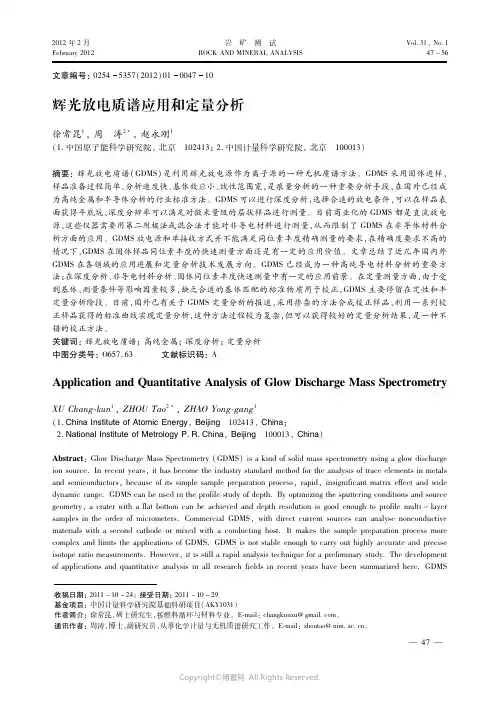
2012年2月February2012岩 矿 测 试ROCKANDMINERALANALYSISVol.31,No.147~56收稿日期:2011-10-24;接受日期:2011-10-29基金项目:中国计量科学研究院基础科研项目(AKY1031)作者简介:徐常昆,硕士研究生,核燃料循环与材料专业。
E mail:changkunxu@gmail.com。
通讯作者:周涛,博士,副研究员,从事化学计量与无机质谱研究工作。
E mail:zhoutao@nim.ac.cn。
文章编号:02545357(2012)01004710辉光放电质谱应用和定量分析徐常昆1,周 涛2 ,赵永刚1(1.中国原子能科学研究院,北京 102413;2.中国计量科学研究院,北京 100013)摘要:辉光放电质谱(GDMS)是利用辉光放电源作为离子源的一种无机质谱方法。
GDMS采用固体进样,样品准备过程简单、分析速度快、基体效应小、线性范围宽,是痕量分析的一种重要分析手段,在国外已经成为高纯金属和半导体分析的行业标准方法。
GDMS可以进行深度分析,选择合适的放电条件,可以在样品表面获得平底坑,深度分辨率可以满足对微米量级的层状样品进行测量。
目前商业化的GDMS都是直流放电源,这些仪器需要用第二阴极法或混合法才能对非导电材料进行测量,从而限制了GDMS在非导体材料分析方面的应用。
GDMS放电源和单接收方式并不能满足同位素丰度精确测量的要求,在精确度要求不高的情况下,GDMS在固体样品同位素丰度的快速测量方面还是有一定的应用价值。
文章总结了近几年国内外GDMS在各领域的应用进展和定量分析技术发展方向。
GDMS已经成为一种高纯导电材料分析的重要方法;在深度分析、非导电材料分析、固体同位素丰度快速测量中有一定的应用前景。
在定量测量方面,由于受到基体、测量条件等影响因素较多,缺乏合适的基体匹配的标准物质用于校正,GDMS主要停留在定性和半定量分析阶段。
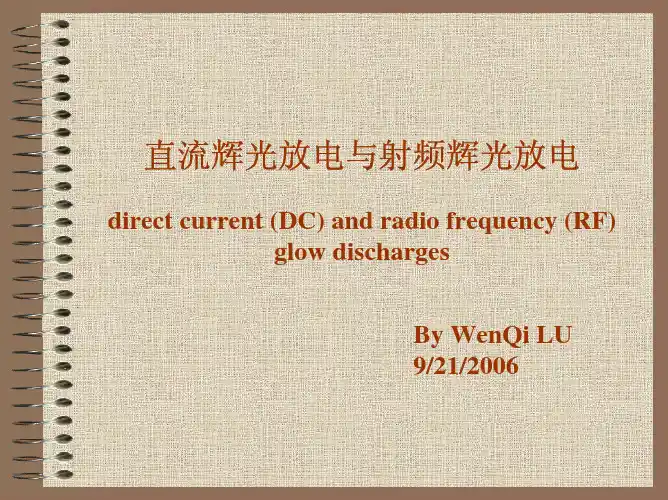
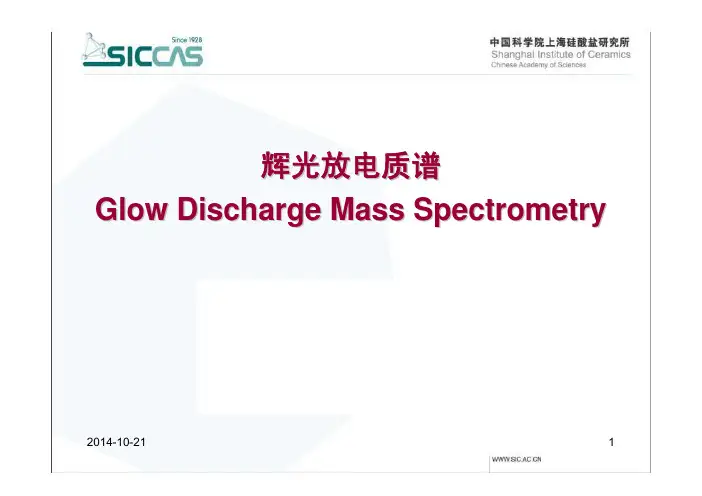
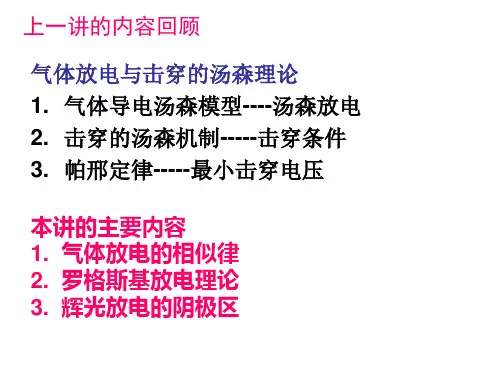
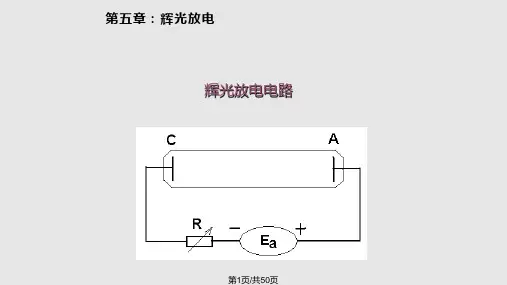
等离子体直流辉光放电一、实验设计方案1)实验目的1、了解等离子体的性质2采用langmuir双探针测量等离子体参数2)实验原理1 、等离子体参数a:等离子体密度:单位体积内(一般以立方厘米为单位)某带电粒子的数目。
n i 表示离子浓度,n e 表示电子密度。
b:等离子体温度:对于平衡态等离子体(高温等离子体)温度是各种粒子热运动的平均量度;对于非平衡态等离子体(低温等离子体),由于电子、离子可以达到各自的平衡态,故要用双温模型予以描述。
一般用T i表示离子温度,T e表示电子温度。
c:等离子体频率:表示等离子体对电中性破坏的反应快慢,是等离子体震荡这种集体效应的频率。
粒子震荡频率:m inie spi02=ω电子震荡频率:m inie spe02=ωd:德拜长度:等离子体内电荷被屏蔽的半径,表示等离子体内能保持的最小尺度。
当电荷正负电荷置于等离子体内部时就会在其周围形成一个异号电荷的“鞘层”。
德拜长度:2、等离子体参数的静电探针诊断原理图8、等离子体探针原理图9、单探针法图10、双探针法假设:(1)、被测空间是电中性的等离子体空间,电子密度n e和离子浓度n i 相等,电子与离子的速度满足麦克斯韦速度分布;(2)、探针周围形成的空间电荷鞘层厚度比探针面积的线度小,这样可忽略边缘效应,近似认为鞘层和探针的面积相等;(3)、电子和正离子的平均自由程比鞘层厚度大,这样可忽略鞘层中粒子碰撞引起的弹性散射、粒子激发和电离;(4)、探针材料与气体不发生化学反应;(5)、探针表面没有热电子和次级电子的发射。
则:对于插入等离子体的单探针有:随机电流:S r A eJ I -=,218441⎪⎭⎫ ⎝⎛==m T n U n J e r根据玻耳兹曼定理:电子密度)exp(0esP kT V V en n -=式中:V p 为探针电位,V s 为等离子体电位所以:探针电流S e e S P A m T kT V V e en I 2108exp 4⎪⎭⎫⎝⎛⎪⎪⎭⎫ ⎝⎛--=π而对于插入等离子体的双探针有:设探针的面积分别为A 1,A 2;电位为 V 1,V 2;电压V=V 1-V 2≥0。
辉光放电与等离子体1、辉光放电通常把在电场作用下气体被击穿而导电的物理现象称之为气体放电。
气体放电有“辉光放电”和“弧光放电”两种形式。
辉光放电又分为“正常辉光放电”与“异常辉光放电”两种,它们是磁控溅射镀膜工艺过程中产生等离子体的基本环节。
辉光放电(或异常辉光放电)可以由直流或脉冲直流靶电源通过气体放电形成,也可以用交流(矩形波双极脉冲中频电源、正弦波中频与射频)靶电源通过真空市内的气体放电产生。
气体放电时,充什么样的工作气体、气压的高低、电流密度的大小、电场与磁场强度的分布与高低、电极的不同材质、形状和位置特性等多种因素都会影响到放电的过程和性质,也会影响到放电时辐射光的性质和颜色。
(1)直流辉光放电①在阴-阳极间加上直流电压时,腔体内工作气体中剩余的电子和离子在电场的作用下作定向运动,于是电流从零开始增加;②当极间电压足够大时,所有的带电离子都可以到达各自电极,这时电流达到某一最大值(即饱和值);③继续提高电压,导致带电离子的增加,放电电流随之上升;当电极间的放电电压大于某一临界值(点火起辉电压)时,放电电流会突然迅速上升,阴-阳极间电压陡降并维持在一个较低的稳定值上。
工作气体被击穿、电离,并产生等离子体和自持辉光放电,这就是“汤生放电”的基本过程,又称为小电流正常辉光放电。
④磁控靶的阴极接靶电源负极,阳极接靶电源正极,进入正常溅射时,一定是在气体放电伏-安特性曲线中的“异常辉光放电区段”运行。
其特点是,随着调节电源输出的磁控靶工作电压的增加,溅射电流也应同步缓慢上升。
(2)脉冲直流辉光放电脉冲或正弦半波中频靶电源的单个脉冲的气体放电应与直流气体放电伏-安特性曲线异常辉光放电段及之前段的变化规律相符。
可以将其视为气体放电伏-安特性在单个脉冲的放电中的复现。
脉冲直流靶电源在脉冲期间起辉溅射,在脉冲间隙自然灭辉(因频率较高,肉眼难以分辨)。
溅射靶起辉放电后,当电源的输出脉冲的重复频率足够高时,由于真空腔体内的导电离子还没有完全被中和完毕,第二个(以后)重复脉冲的复辉电压与溅射靶的工作电压接近或相同。
本章主要内容第6章 等离子体的生成方法6.1 6.2 6.3 6.4 6.5 各种直流放电方法与放电模式 辉光放电与低温等离子体 电弧放电与热等离子体 高频放电产生等离子体 微波放电产生等离子体6.1 各种直流放电方法与放电模式•直流放电法– 冷阴极放电 – 热阴极放电 – 空心阴极放电 – 磁场辅助放电(磁控管放电)" 直流放电的特征:1. 电极上所加电压在极性上是恒定的,正电位端为阳极、负电位为阴极; 2. 等离子体的生成与维持主要通过阴极鞘层中的电子加速和等离子体中的 焦耳加热来实现;• 冷阴极放电与热阴极放电的区别– 冷阴极放电依靠阴极的二次电子发射来维持放 电,热阴极依靠阴极本身的热电子发射来维持放 电; – 热阴极放电需要较高的阴极温度 (1000‾3000oC),但在低气压(如0.1Pa)下 仍能维持放电; – 冷阴极放电需要较高的着火电压与放电维持电压 (用于加速离子),而热阴极放电的放电维持电 压较低; – 冷阴极放电器件不需要加热灯丝有较长的寿命, 且节能,热阴极放电器件有较高的功率;• 空心阴极放电的原理与优点– 阴极面积大,易于产生较高的电流密度,从而 得到高密度等离子体; – 空心阴极放电的阴极属冷阴极,依靠二次电子 发射维持放电; – 空心阴极有利于提高电离效率• 径向电子运动在一定条件下可以维持很长的寿命, 从而增加其参与电离的次数(条件:平均自由程大 于圆筒半径,阴极表面的鞘层厚度小于圆筒半径, 电子在另一侧鞘层内被反射) • 阳极面积小,可以减少阳极对电子的吸收,加强放 电;• 利用磁场的潘宁电离规– PIG, (Penning ionization gauge); – 磁场(~0.1T)辅助放电器件适合用于压强很低 情况下(10-4Pa)放电; – 磁场起引导作用,使其在两端阴极之间来回运 动,增长其寿命,加强放电; – 属冷阴极放电,二次电子维持放电;• 磁控管放电– 属冷阴极放电,二次电子维持放电; – 阴极表面的磁场与正交电场使电子产生E×B漂移,电子作旋 转式摆线运动,增长了电子的寿命; – 主要应用:磁控 溅射 – 参数范围:气压 mTorr,放电电 压几百伏 – 高能离子撞击阴 极溅射出阴极材 料,堆积到对面 基板形成薄膜三耙磁控溅射仪• 直流放电模式– 标准直流放电模式(V-I关系,伏-安特性)提示:电压可调节,电阻会分压• 直流放电模式分析– a‾b: 放电开始阶段,电流随电压的升高而增加,形成 的微弱电流不稳定(暗流); – b‾c: 着火阶段,到达着火电压后,电流迅速增大,c点 即放电着火状态; – c‾d: 前期辉光放电阶段,电流增大,电压却下降,产 生负阻(原因:等离子体密度的增加使等离子体电阻 变小); – d‾e: 正常辉光放电阶段,增大电流,电压一定(原因: 电流密度一定,导电面积增加); – e‾f: 反常辉光放电阶段,电压随电流增大(导电面积 饱和); – f‾g: 过渡到弧光放电;" c~f过程可以看到等离子体的辉光现象,故称这种放电为辉光放电(glow discharge)6.2 辉光放电与低温等离子体•辉光(glow)明亮、温暖而又稳定的光;•是直流放电中的一种形态,常见于低温冷等离子体(低温、非平衡);•日光灯、PDP中的放电都属于辉光放电;•近年半导体加工工艺中用到的高频放电也会产生类似现象,称为射频(RF)辉光放电•辉光放电的放电特征–发光区域的划分–外加直流电压主要加在阴极到负辉区之间(d c )–p d c 对应帕邢曲线最小着火电压处的值–负辉区和法拉第暗区出现的理由–正柱区是准中性的等离子体区域–阳极附近存在阳极暗区,是阳极鞘层(电子鞘层)6.3 电弧放电与热等离子体•电弧放电–气体放电中最强烈的一种自持放电,当电源提供较大功率的电能时,若极间电压不高(约几十伏),两极间气体或金属蒸气中可持续通过较强的电流(几安至几十安),并发出强烈的光辉,产生高温,这就是电弧放电;–电弧是一种常见的热等离子体(T=T i,平衡);e–电弧放电最显著的外观特征是明亮的弧光柱和电极斑点,电弧分短弧和长弧;–在外力作用下,如气流、磁场,电弧会迅速移动、拉伸或蜷曲;–电弧放电中阴极电子的发射方式一般为热电子发射或场致发射用于生成碳纳米管的100A电弧体育场用弧光照明系统汽车的氙气灯电弧形貌电弧照明160kV下的强电弧,电极间距30cm电弧喷涂电弧焊接•热电子发射电弧放电–在辉光放电中,随着放电电流的增大,大量高能量等离子体碰撞阴极使其温度上升–阴极热电子发射满足Richardson-Dushman方程,其饱和电子发射流随温度升高而增大–当放电的V-I特性曲线与外电路的负载直线相交时,放电电流趋于稳定–阴极材料选择对实现弧光放电很重要,常见的有钨、钼等Richardson-Dushman方程•场致发射弧光放电–在常温状态下,对阴极表面施加强电场,由于隧道效应,电子从阴极发射出来;–当等离子体电位达到100V以上时,接地等离子体容器内的污染表面容易出现许多闪烁辉点,这也是一种场致发射引起的电弧放电-微电弧;–在很多场合下,热电子发射和场致发射兼有;–典型应用:水银电弧。
辉光放电的特征范文辉光放电是一种在气体中观察到的放电现象,具有独特的几个特征。
下面将介绍辉光放电的特征,并说明其在不同条件下的变化。
1.光辉特征:辉光放电具有辉光现象,呈现出光亮的特征。
辉光放电的颜色可以因气体成分不同而有所区别,例如氮气中的辉光为紫色,氩气中的辉光为蓝色。
辉光强度取决于放电电流和电压的大小,强电流和高电压会导致辉光更加明亮。
2.电压特征:辉光放电的特征之一是需要一定的电压来维持。
当电压升高到临界值时,放电才能发生。
这个临界电压取决于气体种类和放电环境条件。
在低压条件下,气体辉光放电通常需要数千伏的电压,而在大气压力下,辉光放电仅需要数百伏的电压。
3.显露特征:辉光放电在气体介质中呈现出一系列显露特征。
这些特征包括暗电流阶段、启动阶段、正常放电阶段和打火阶段等。
辉光放电的暗电流阶段是在较低电压条件下,气体中的电子开始加速。
启动阶段是在辉光放电初期,电压逐渐升高,电子与气体分子发生碰撞,产生新的电子和离子。
正常放电阶段是电子与离子之间的复杂相互作用过程。
打火阶段是当电压超过临界值,辉光放电开始产生的过程。
4.形态特征:辉光放电通常呈现出放电通道的特征,这称为辉光通道。
辉光通道可以是直线的,也可以是呈弧形或环形的。
通道的形状取决于电极的排列方式、电压大小和气体条件等因素。
辉光通道的宽度也会随着电流和电压的增加而变化。
5.电流特征:辉光放电通常伴随着电流的流动。
电流的大小与放电电压和气体种类有关。
在辉光放电时,电流可以是连续的或脉冲的。
在脉冲辉光放电中,电流的脉冲周期和脉冲宽度会受到控制,并且可以通过调控电压和气体压力来改变电流的强度。
6.断裂特征:辉光放电的一个显著特征是其放电路径会发生断裂。
断裂通常是由于电子的能量耗尽或物质的不稳定造成的。
断裂的位置会在辉光放电通道内部不断变化,导致辉光放电的瞬间闪烁。
总结起来,辉光放电的特征包括光辉、电压、显露、形态、电流和断裂等几个方面。
这些特征得到了广泛的研究和应用,例如在发光器件、放电管和激光装置中的应用。